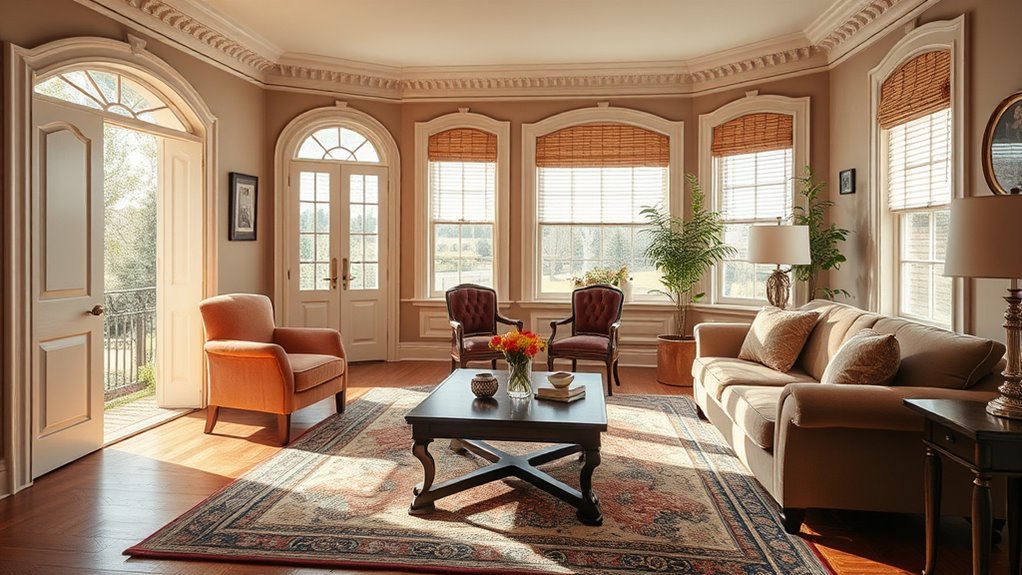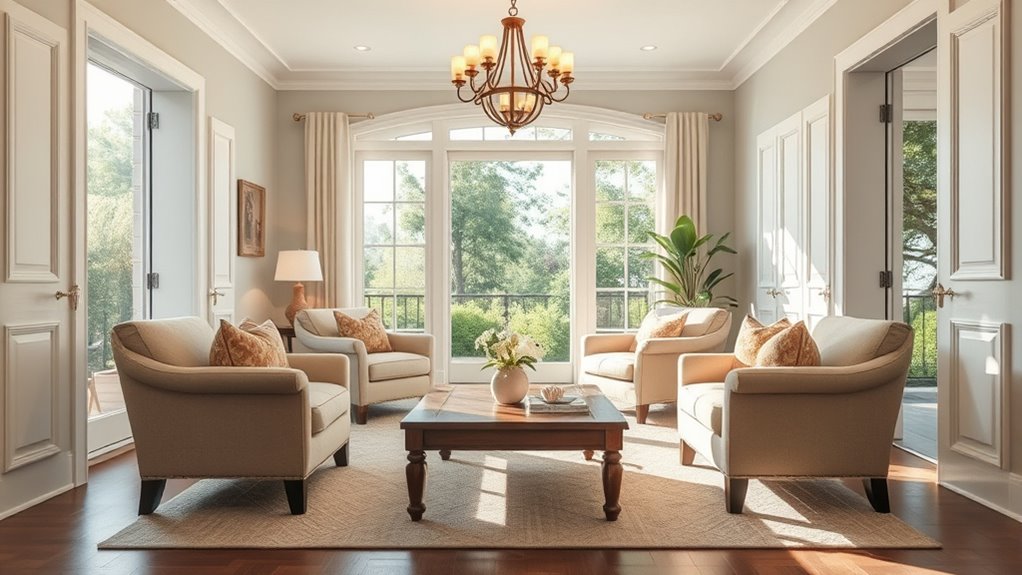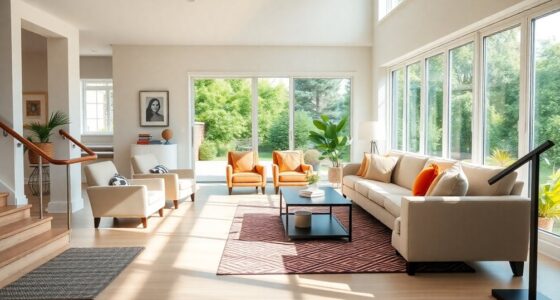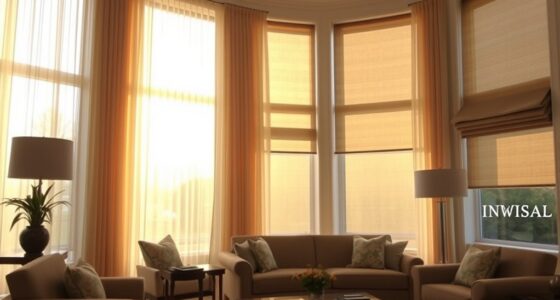Timeless interior styles that meet accessibility needs blend classic, elegant designs with practical features for safe, independent living. Think of clean lines, open layouts, natural light, and contrasting colors that improve visibility. Use durable materials like wood and textured surfaces for safety and style. Incorporate accessible elements like wide doorways, lever handles, and adjustable features while maintaining an uncluttered, symmetrical appearance. If you want to discover how to create these harmonious spaces, keep exploring these ideas further.
Key Takeaways
- Classic interior styles like traditional or rustic ensure timeless elegance while incorporating wide doorways and open layouts for accessibility.
- Neutral color palettes and high-contrast accents enhance visibility and orientation for individuals with visual impairments.
- Use of durable, natural materials such as wood and stone provides both style and safety through textured, non-slip surfaces.
- Incorporating lever handles, adjustable features, and clear pathways promotes independence and safety for mobility aid users.
- Symmetrical, uncluttered designs with rounded edges and integrated safety features create inclusive, enduring interiors.

Creating an accessible interior isn’t just about compliance; it’s about designing spaces that everyone can enjoy and navigate comfortably. When you choose a timeless style, you’re creating an environment that remains elegant and functional for years to come while also respecting diverse mobility needs. Think about the classic charm of a minimalist design—clean lines, uncluttered spaces, and simple color palettes. These elements naturally lend themselves to accessibility because they reduce visual confusion and make pathways clear. You can incorporate wide doorways and open floor plans without sacrificing style, ensuring that movement is unrestricted for those using mobility aids like wheelchairs or walkers.
Incorporating natural light and high-contrast color schemes is also a hallmark of many timeless styles, and they serve an accessibility purpose as well. Bright, well-lit spaces help those with visual impairments navigate more easily, and contrasting colors on floors and walls improve depth perception. For example, dark rugs on lighter floors or contrasting trims around door frames can be both aesthetically pleasing and functional. When selecting furniture, opt for pieces with rounded edges and stable bases. These design choices not only add to the classic appeal but also minimize injury risks for everyone, especially those with balance challenges.
Materials and textures play a significant role in creating an accessible environment. Traditional styles often emphasize natural materials like wood, stone, and woven fabrics, which are durable and easy to maintain. Smooth, non-slip flooring options like polished wood or textured tiles help prevent falls, making the space safer for all users. You should also consider adjustable features, such as countertops or shelving, that blend seamlessly into the design. These modifications ensure that the space remains adaptable over time, accommodating changing needs without compromising style. Additionally, fostering attention in design can help ensure that accessibility features are seamlessly integrated without disrupting the aesthetic.
Finally, timeless interiors often feature a neutral color palette and balanced symmetry, which can be soothing and easy for anyone to interpret visually. Incorporate accessible storage solutions that keep clutter out of the way but are still within reach, supporting independence. By integrating these classic design elements with thoughtful accessibility features—like lever handles instead of knobs, ample lighting, and clear pathways—you create a space that’s both elegant and inclusive. A timeless interior, when thoughtfully designed, offers comfort, beauty, and usability for everyone, regardless of physical ability, making your home welcoming and functional for years to come.
Frequently Asked Questions
How Can I Incorporate Universal Design Principles Into My Interior Style?
You can incorporate universal design principles into your interior style by choosing furniture with easy-to-reach heights and clear pathways, ensuring good lighting everywhere, and selecting contrasting colors for better visibility. Opt for lever handles instead of knobs, and avoid clutter to improve mobility. Mix timeless styles with functional features, so your space remains stylish while being accessible. Prioritizing comfort, safety, and ease of use helps create a welcoming environment for everyone.
Are There Specific Color Schemes That Enhance Accessibility and Style?
Like the clarity of a Monet painting, choosing accessible color schemes enhances both style and function. Opt for high-contrast combinations, such as dark text on a light background, to improve readability. Stick to muted, neutral tones with bold accents to create a timeless look. Avoid overly busy patterns or color clashes. These choices guarantee your space is welcoming, functional, and visually appealing for everyone, much like a well-composed masterpiece.
What Affordable Modifications Improve Accessibility Without Sacrificing Aesthetics?
You can improve accessibility affordably by adding non-slip rugs, which enhance safety and style. Installing lever handles instead of knobs makes doors easier to open. Use contrasting colors for edges and important features to assist those with visual impairments. Swapping out standard light switches for rocker or dimmer switches adds both function and modern appeal. These simple, budget-friendly modifications boost accessibility without compromising your home’s aesthetics.
How Do I Select Furniture That Balances Style and Functionality?
You can’t afford to overlook the magic of multifunctional furniture—it’s a game-changer! To balance style and functionality, choose pieces with clean lines and neutral colors that blend seamlessly with your decor. Prioritize comfort and ease of use, like chairs with supportive arms or adjustable height tables. Measure your space carefully, and look for designs that are both visually appealing and practical, ensuring your home feels stylish and accessible at the same time.
Can Accessibility Features Blend Seamlessly With Vintage or Traditional Interiors?
Yes, accessibility features can blend seamlessly with vintage or traditional interiors. You can choose discreet modifications like low-profile ramps, lever handles, or furniture with built-in grab bars that match your decor’s style. Incorporate period-appropriate materials and finishes to hide modern elements, ensuring they don’t detract from the aesthetic. With thoughtful planning, you’ll create a space that’s both charming and accessible, maintaining the timeless appeal of your interior.
Conclusion
By blending timeless interior styles with thoughtful accessibility features, you create a space that’s both beautiful and functional. It’s like crafting a cozy, welcoming home that adapts effortlessly to your needs, no matter what they are. When you prioritize ease of movement and inclusive design, your space becomes a reflection of your thoughtful approach to living. Embrace these styles, and watch your home transform into a sanctuary that’s as stylish as it is accessible.









